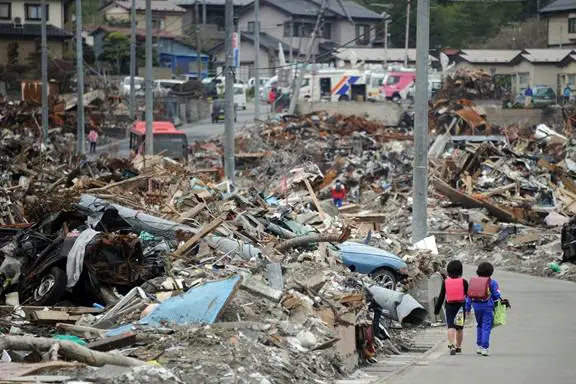I don’t have any dreams [for the future].
—Nozomi M., living in an institution, Osaka, December 2011
Without Dreams: Children in Alternative Care in Japan
In a country with falling birth rates, an aging society, and an alarming population crisis, thousands of children are slipping through the cracks. Japan’s failing foster care system creates a bubble of isolation from society through which children leave unprepared for the transition into adulthood. Children are moved from abusive homes to neglectful institutions, facing poor living conditions, physical and sexual abuse, and little support for their future.
In 2021, the Ministry of Health, Labor, and Welfare of Japan reported that the number of child welfare cases received nationwide reached almost 600,000. For years, the number has been steadily increasing. More and more children without available family placement have been funneled into Japan’s alternative foster care system, primarily large institutions. Japan is far behind almost every other developed country on this metric.
History of the System
Each year, the number of cases received by children guidance centers in Japan increases significantly. In 2015, the number of cases received were 434,245 while the center received 573,480 in 2021. Excluding 2020, every recorded year by the Ministry of Health has shown increasing numbers. Although the number of children placed in care has not significantly increased, a larger percentage of children are being placed due to Japan’s shrinking population crisis. Children who are finally removed from abusive or neglectful homes are often placed into massive foster care institutions with little personalized care or attention.
These issues are not new. Since the beginning of the Meiji Era (1868-1912), orphans, called koji, were often viewed in a negative light. This word did not just include children without parents, but children whose parents have passed away, gone missing, or abandoned them. Children given this designation suffered from societal and institutional mistreatment.
After a series of wars ending with World War II, Japan suffered a series of issues relating to the management and miscount of orphaned children. Often, children left neglected on the streets or with poorer relatives or communities were later funneled into prisons for delinquent reform after committing various crimes. Many ran away after mistreatment.
Kisako Motoki, a World War II orphan, spoke about her life after being orphaned by the war. She had no choice but to go to relatives’ homes where she and her brothers were verbally or physically abused, while receiving no government support. “How could we, as children, have spoken up against the government?” she remarks. “They abandoned us, and acted as if we never existed.”
Kisako’s story is a reflection of many orphans unable to make it into the institutional orphanages already at capacity. Many others ran away from mistreatment by relatives or other families and lived on the streets, making a living through menial tasks like shining shoes or selling newspapers.
Although Japan’s current foster care system has improved in capacity and conditions since the war, it has struggled to shift to a more modern system. In 2014, infants and young children under 3 years of age were reportedly often housed in institutions where they are not given the proper individualized attention and care. Child development specialists suggest that children in institutional care often develop various disorders or developmental delays. According to the Japanese government, a quarter of children in the system had a form of disability in 2014. Often, these children are sent to institutions that separate them from their peers and restrict their movements and freedom.
Institutionalization in Japan is still very common; in 2021, 3,792 foster care children were immediately relocated to large or house-based institutions, as compared to 617 placed in foster family homes. This would suggest that around 16% of children were placed in family-based homes. Thousands of children live in facilities with very little individualized attention, the chance to form meaningful relationships with caretakers, and opportunities for further growth. The government passed the Child Welfare Act in 2017, which aims to place at least a third of foster children in homes by 2029. However, this is still far behind many other developed nations. In 2016, South Korea placed 47% of children in foster care families. In 2019, The United States placed 82% of children in foster care families. At the start of 2020, the United Kingdom had placed 72% of children with families.
Isolation
Children separated from family-based institutions face challenges in everyday life. Without individualized attention and care, children are often deprived of everyday items and wants, leaving them disconnected from their peers. This can continue even after youth have transitioned out of the system.
The Japanese government began to consider bridging a “digital divide” in July, well after many Japanese children and teenagers had begun using smartphones in school and everyday life. In 2020, the Cabinet Office of Japan reported that 86.6% high school students use smartphones. By contrast, few institutions in Japan provide teenagers with smartphones. Without the ability to communicate and socialize with others digitally, a barrier is placed between children with and without. This instance illustrates the glaring issues with placing teenagers in institutions where there is little time to consider each individual’s daily needs and items.
This isolation can spread to foster youth attending school. In 2014, only 73% of children completed high school while in alternative care in Tokyo, and only 15% completed some form of higher education. Insights from former foster youth can provide a look into the isolation many children experience at schools.
Raika Tanaka, a former foster youth, explains how having to save money for college needs with no financial backing led to her feeling isolated at college. “There was a huge gap between me and the other students,” she recalls. Many students were able to use money for leisure activities, and often used these events to socialize. “When going to a karaoke or cafe with your friends, it takes some money, right? So I kinda had to give up socializing or hanging out with my friends.”
After the System
Children transition out of the system at eighteen years old. Between the ages of 18 and 20, however, navigating life without relatives or contacts is extremely difficult. The system provides minimal support to children in this transition period.
Signing any contractual agreement to rent an apartment, register for needs, or sign a workplace contract used to require a guarantor to confirm their commitment to the contract. Before 2022, according to Japan’s Child Welfare Act, individuals over 18 were considered adults. However, under the Civil Law Act, individuals were not considered adults until 20 years of age. Contractual agreements were, therefore, extremely difficult to obtain.
“Almost all of them suffer from a lack of a guarantor,” says Marika Kikuchi, the chairperson of an organization providing livelihood support to former institutionalized Japanese youth. “We need a guarantor when making pretty much any contract… as far as the first contract… the principal of [the] orphanage can be your guarantor… but [former foster youth] do not have a guarantor at some point.”
Japan addressed this on April 1, 2022, when the legal age of adulthood was lowered to 18. However, former foster youth are still struggling with the consequences of these conflating laws. They still face the varying consequences from a lack of outside support.
Many issues stem from the lack of monetary support when navigating adulthood. Satoshi Brojan, a former foster child, was unable to attend college or explore certain job options after transitioning out of the system. “I had no money,” he explained, “so my only choice was finding a job that offered a room to their employees.”
Those who turn to their former parents for support often land themselves in crisis. “Sometimes, after leaving… they’re still abused by their biological parents,” Kikuchi says. “The parents blackmail or steal their money and just disappear again.” This worsens situations for youth attempting to re-stabilize their lives in adulthood.
Japan’s Demographic Crisis
In the last few decades, Japan has continued to face the repercussions of a steep population decline. The population’s average age is increasing, and fewer children are born each year. Although this is a crisis occurring in many developed countries around the world, it is particularly prevalent in East Asia.
Today, Japan is still failing their foster youth. Despite facing a huge demographic crisis, the country has ignored thousands of children. Many of these children have the ability to contribute well to an already aging society when adults, yet are often institutionalized and face large setbacks to growth, learning, and career development. Until Japan’s government can clearly address the issues with their failing system, millions of children will continue to fall through the cracks. Japan must make a larger effort to ensure abused, neglected, and orphaned children are supported and loved.
Featured Image: Children walking alongside rubble from the 2011 Tōhoku tsunami. May 2011. © 2011 Toshifumi Kitamura/AFP/Getty Images.






Comments are closed.